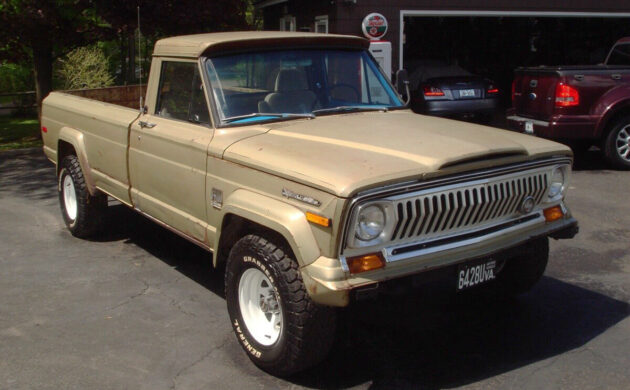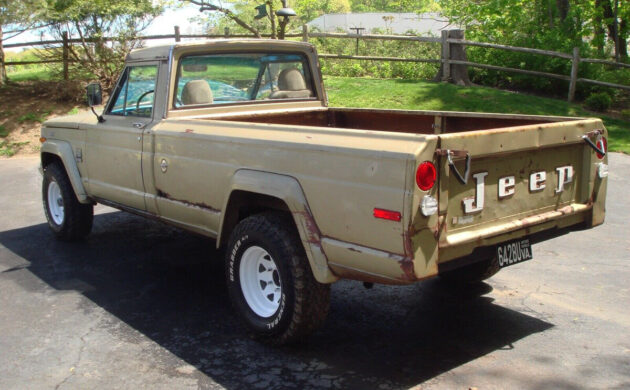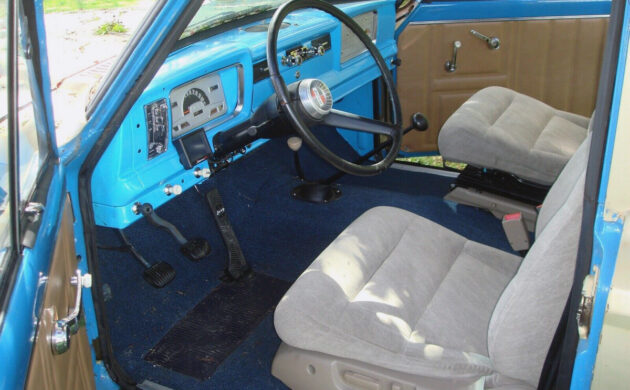Every time I see a Jeep pickup, I’m reminded just how cool they were, and I’m bummed that they don’t make one now. And, I don’t mean the new Gladiator based on the Wrangler, especially since that one only comes with four doors. I mean, not that a real truck has to have two doors. This 1971 Jeep J4000 is listed here on eBay in New Windsor, New York and there is a $7,500 buy-it-now price or you can make an offer.
This is the big one, the J4000 with a 132-inch wheelbase, although there was at least one other model with a longer wheelbase. Most people know the J2000, the shortlived J3000, and J4000 from this era. After the end of 1970, the Gladiator name went away for a while, replaced by the J2000/3000/4000, but only for three years, then it changed again to the J10 and J20. A 1971 Jeep brochure shows this truck as the Gladiator J4000, so there was some carryover during 1971, I’m guessing similar to when Nissan changed its US nameplates to Datsun by Nissan, and finally just Nissan.
This truck has some rust issues to deal with. The next owner will learn how to weld, or they’ll become very tired of welding before the body is fixed on this 4×4. It’s everywhere on the body, but oddly enough, the underside looks good. It also has some new parts and modifications under there and under the hood. The bed looks pretty solid but has heavy surface rust that should eventually be treated before it becomes a problem. This truck has the Townside box but a Thriftside (stepside) would also have been available, as well as a cab and bare chassis.
So this was a blue truck? If so, I’d bring it back to that Smurf color, whether it’s a popular color or not. The seats have clearly been changed and the seller says that the driver’s seat is power-operated. They give an absolute novel of information on this truck so please read the description. The seller says that this truck has the original paint, could there have been a bright blue interior in a gold truck? I don’t know if I’ve seen that before.
I did not expect to see that engine here! Nice. A 232-cu.in. inline-six was the standard engine but this is an AMC 360-cu.in. OHV V8 with a Holley Sniper fuel injection system (fantastic!) and a crazy long list of new parts and what’s been done to this beast. This engine makes the truck for me, along with that three-speed manual inside. Would the rust hold you back from buying this one?







1st, nice truck and if I may, the last of the Mohicans, end of the line, meaning, a transitional period for Jeep pickups. Kind of an identity crisis. Not quite Kaiser, not quite AMC,,yet. 2nd, the dash was painstakingly(?) painted,( I read, ’72 was the last year for this style dash) and 3rd, this is the one to have before they were AMCized. This was kind of the last of the Kaiser, and the beginning of AMC. Not that it was a bad thing, just AMC cheapened them up considerably, but the Jeep toughness remained.
For me, the motor is a total deal breaker in an otherwise great find, 1st thing to go. While I’ll admit, a 6 could come up short here, a simple 304 , 2 barrel, or F.I. is nice, is really all that’s needed for what this truck SHOULD be used for. Some states require bumpers but an overall great find. The rust is minimal considering what most of these turned into.
1972 was the last year for that dash layout, correct. In the Kaiser years, the dash was painted the exterior color. There may have been an upgrade option on the Super Wagoneer, but every J-Series I’ve seen had the dash the color of the body.
I believe a bright blue was on the (limited) color palette in those years.
The 1973 and later dash used the same metal basis, but had an entirely-different instrumentation layout. Three round clusters, which I believe came right off the Hornet line. Then a big layer of padding over the right side of the dash – the dash frame was symmetrical, I guess to easily allow right-hand drive assembly, with the passenger’s side having a speaker grille. In 1973 that got covered with thick padding and a speaker opening was made on the top of the dash.
The glovebox is identical – except that the clock, which had been mounted in the glovebox door, was moved to what had been the passenger-side ashtray. Passenger had to share the driver’s tray, from that point.
AMC apparently hated the Kaiser nomenclature…the Gladiator name was dropped sometime in 1970, but probably the sales brochures were ordered before the decision. My only question would be, when exactly was the body sheet-steel thinned out. It would have been in 1970 or 1971, and for longevity, it made a lot of difference.
The FI conversion is a real plus, today with E-20 gasoline.
I’m with you on the engine Scotty a 390 or 401 would also work.
I’m with you Howard, the engine is too much for a work truck. What year did the 258 come out? BTW, I read you are from Colorado but originally from Wisconsin. I have spent a summer in Northern Wisconsin, it was really nice (Plus some time in the southwest drift less area, that was truly awesome). What made you leave? Not like you were escaping the snow going to Colorado.
Great truck,ticks all of the boxes. Paint looks original based on the engine compartment. The rust is pretty much everywhere but the price is nice if the frame and underside are solid.
Some rust? No the sum of rust!
Something about the new jeep trucks feels like they’re meant for men who need an SUV, but want to be seen in a truck. Nothing like the trucks they used to make.
That’s true of virtually all trucks made today.
And driving one makes you a really cool dude –
at least according to the commercials.
That’s true, but also, it’s the lack of anything remotely decent offered today. Trucks are the last holdout for people who want a “real”, conventional type vehicle, and a market that car makers can’t ignore. For example, in 2021, US sold 3.3 million cars and a whopping 11.6 million light trucks. Can’t argue with those numbers. It, I feel, is a recipe for disaster, as most truck buyers today, due in part to their extreme cost, won’t be buying too many more, and then what? Far as they aren’t the same, well, that’s true, but we’ve evolved away from these rattly door, poor handling and riding gas hogs, and that’s not all bad.
I agree completely, E, and they don’t look like trucks anyway. And unfortunately, with their 60 grand price tag, us real truck guys are gonna label this one a status symbol. Honestly, I have seen more of these lately in my area than older Jeeps, and most of them carry the traditional ‘trail gear’, shovels, jacks, gerry cans, and I’ve even seen a couple with snorkels.. and I just have to chuckle, because not one of them has a speck of dirt on it anywhere, a nice fresh coat of armorall on the 36″ mud/terrains. I want to see just one of them ‘painted brown’, ie, having been off road and covered in copious amounts of mud… I thought about test driving one and casually painting it brown before returning it, but I’m afraid they’d call the law on me .. c’mon, big spenders! Paint ’em brown! I’d take the truck in this ad, rust and all, over a new gladiator 100 times over, cuz they will never be what it is, a true Jeep truck!
Gladiator-thought that was a good old joke.Always liked the style of these trucks.Thought it was a Comanche.360 fits good in it.Would put a smile on my face with hair between my teeth.😆lol
My favourite grill on my favourite Jeep with my favourite transmission and favourite AMC engine. Unfortunately, my favourite bank account is depleted.
exactly how I would like it. Nice interior, running gear great, body awful. I’d sandblast the bed, and Rustoleum it.
This truck belonged to a friend of mine here in va beach. I am very familiar with it. It runs and drives very good. It was put together well with alot of documation and pictures during the build.
Question..
During the 60s and 70s my uncle had a Rambler/AMC dealership. Sometime in the 70s he had a jeep pickup with a 350 Buick motor in it. Did AMC use Buick engines?
Thank you.
Yes they did. For a couple years between the AMC 327 and AMC 360/401, the Buick 350 was used in full sizers (and they also used the Buick V6 in Commando/Jeepsters)
Thank you.
Kaiser was flailing, engine-wise. They started the J-series products (J-100 panel truck; J-X000 Gladiators, and the Wagoneer) with an inline six they made off Continental’s original designs. Along with the Wagoneer/Gladiator they engineered their own overhead-cam head.
That didn’t work out. Too rushed, and the engine block wasn’t strong enough for the power and intended use of these vehicles.
By 1965, Kaiser had struck a deal with AMC to buy both OHV sixes and their 327 V8s, into their FSJ offerings. Coinciding with Kaiser Industries’ purchase of AMC stock.
THAT remained until 1968 – when, IIRC, the 327 V8 was discontinued in favor of AMC’s GenII V8s.
Meantime, Kaiser had begun cozying up to GM…first, it was the Buick V6…which was first put in CJs at a Western Buick and Jeep dealer. Might have been Warn – I don’t recall.
But Kaiser brass was alerted, and tested the conversion. They liked and approved, and began buying those V6s for factory installation. In fact they liked it so well they later bought the engine line, when GM went to phase it out.
That while the new Postal DJs gained a Chevy II four. Finally, the adoption of the Buick 350 in the J-Series rigs in 1968. And THAT was a spectacular addition – the Buick had lighter weight and more power than the AMC.
Of course, while that was happening, Henry Kaiser went the way of all flesh. He owned Kaiser Industries, outright; and his heirs had to raise Estate Taxes.
Kaiser Jeep was the first to go – since, with the FMVS Act of 1966 and EPA emissions standards, there was no way for Jeep, even profitable, to raise the cost of engineering smog fixes.
Kaiser Industries used its interest in AMC to sell them on the idea of buying Jeep – it was a contentious move at the time; Gerald Myers was one of its most-powerful opponents.
But Jeep, using three GM engines, went to AMC. That was in May 1970. The Wagoneer got a new AMC-style front grille right away, and the Gladiator got the old Wagoneer “Razor” grille. But, Buick engines kept going in until somewhere in the 1971 year.
Popular Science did a road test of utility wagons, including Wagoneer, Travelall and Suburban, and noted the incongruity of having the AMC red-white-and-blue brand on the Jeep, along with the Buick engine.
If I was guessing I’d say that the exterior color of this truck is as it came and the bright blue interior came after.
The rust through area in the tailgate can be difficult to repair, and the bed seam on the driver side looks like it’s about to break through if it already hasn’t…another difficult area to repair.
These are heavy trucks – as all full size Jeeps were – and a 360 is a perfect balance of power and torque for these. They didn’t use 304’s for a reason. This looks like a nicely done build and having the f.i. upgrade makes it even better. It’s not going to magically give you better gas mileage (maybe 11-12mpg instead of 10-11) but the reliability is a huge gain.
I don’t know, for sale in New York, but Virginia antique vehicle plates. That for a native Virginia resident, scares us. Don’t get me wrong, there can be legit reason for that. IE lived in Virginia but moved to New York. But since there are two things that make it worrisome, one Virginia requires an inspection on everything but antique tagged and farm use. And two given that, you don’t actually have to be a living in Virginia to get a vehicle registration from Virginia, it leaves me wondering if there’s more significant issues, like frame issues we aren’t seeing. Usually here vehicles over 25 years old or older that will not pass inspection are given the antique plates. Usually even classic cars here is more worth it to get it passed inspection and regular tags. Because of limitations on how much it may be driven and how far you may be away from the place of residence. So a little suspicious on this one.
Auction update: this one ended with no sale, was relisted at $6,500 and the seller accepted a “best offer”, according to eBay.